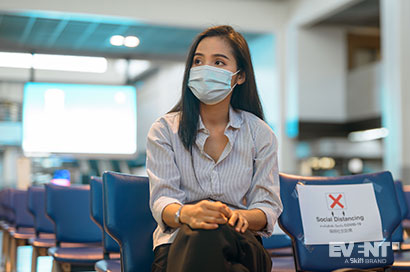Is Profit Possible for Live Events With Social Distancing?

Skift Take
The disruption of the Covid-19 pandemic’s restrictions on gatherings and travel have forced many of 2020’s events to cancel, postpone, or pivot to virtual. The move to virtual in particular has been a long time coming, and virtual engagement will continue to be necessary to keep business going.
That said, people crave a return to normal and the recent WHO guidelines for meetings and events shed a dim light at the end of the tunnel. While the industry itself is split on whether or not to restart business (and when), the economic pressure is motivating some countries and US states to undertake the experiment of reopening events. Any authorization to put on a live event will ultimately be tied to a demonstrated ability to follow health recommendations and enforce social distancing rules.
The first events to come back will be small and local, and they’ll face a number of challenges. Apart from having to prove the concept of safe social distancing in a business meeting context, they will also have to face increased costs spread over a reduced headcount.
In this post, we take a look at the impact of health and safety measures on budgets, the effect of social distancing and a reduced capacity on revenue, and the role virtual engagement will play in moving the needle towards a viable ROI.
What Are the Consequences for Budgets?
CLEANING, SANITIZING, AND PREVENTION SUPPLIES
In order to follow health recommendations, event organizers will first have to up their game in terms of cleaning and sanitization. Regular cleaning and disinfection of surfaces and objects that are frequently touched will be a must during events, and organizers will need additional staff on-site to make sure it is done properly.
Prevention supplies will also have to be made available to everybody, including the organizer’s staff, vendors, exhibitors, attendees. This means setting up hand sanitizer stations and providing disposable facemasks.
This Translates Quite Directly To An Increase In Cost.
While some of the costs could theoretically be deferred to vendors, exhibitors, attendees (e.g. BYOM or ‘bring your own mask’), or sponsors, it’s safe to say that event organizers will need to secure and provide supplies anyway.
As for the sanitizing of areas and surfaces, it could be part of what venues might want to offer to their clients, but they also suffered greatly from the pandemic and the loss of revenue, and will have to share that cost one way or the other.
PLANNERS MAY HAVE TO GO ABOVE AND BEYOND
Moreover, planners may have to go above and beyond the measures required to meet safety criteria in order to combat the reluctance on the part of attendees to brave the risk of an in-person event (or to follow guidelines once they get there). These could include the provision of potentially more costly N95 or equivalent masks, or creating other sanitary barriers and infrastructure like information signs, posters, etc. instructing people of what they need to do.
These measures may also evolve as new preventative measures (UV light air purification, canine assistance, etc.) continue to be researched and validated, and planners will need to keep abreast of these developments to ensure that they create the safest possible environment for their attendees.
What Are the Consequences for Revenue?
The question of how much the cost will be and who will absorb it is compounded by the fact that the revenue for paying it at a physical event will be spread thickly over a much lower head count.
As of today, gatherings of more than 10 people are not allowed in most places. Where exceptions are being made for planned meetings and events, the proximity of attendees to one another as well as the density of attendees within a confined area are important factors for mitigating risk.
For event planners, this means enforcing strict social distancing rules that will ultimately limit the capacity for meeting rooms and venues.
These rules vary widely depending on the country. In the US, a distance of six feet between people is advised, while some other countries like France or Denmark have reduced the distance to about three feet.
However, it’s prudent for planners and venues to take the most conservative guideline as the rule. As we established in a recent interview with epidemiologist Dr. Brian Labus, any gatherings indoors pose an increased risk of virus transmission for a number of reasons. One of the most concerning is that the concentration of aerosolized virus within the ambient air in a session or meeting room could increase over time (10 to 30 minutes is the exposure criterion used in contact tracing measures).
This build-up of the viral load in the ambient air reduces the efficacy of even the more conservative six-foot social distancing standards many are using as a guideline.
CUTTING CAPACITY MEANS REVENUE LOST
To enforce social distancing, event organizers will have to reimagine the event flow and floor plans. Room capacities and setups will need to be adjusted to allow a certain distance between tables (which will inevitably feature fewer seats), larger aisles, tape marking on the floor to visualize the correct distance for people standing in lines, a strict direction for flows, etc.
At trade shows, social distancing will automatically reduce the number of exhibitors to manage more circulation space, which means less revenue coming from plot rentals.
The effects on venue capacities will be dismal. We can expect a reduced capacity of potentially more than 50%, and some venues are expecting to have to operate at as little as 20-40% of their normal capacity.
This could be unmanageable if venue rental and other costs remain unchanged. Venues will have to adapt their prices (and potentially their business models) to take this into account, or it might be hard for a lot of them to justify even opening their doors.
TRAVEL RESTRICTIONS REDUCE TURNOUT
Another consequence of the pandemic is that many people might be reluctant to travel to the event even if it happens. Some countries have adopted a 14-day quarantine period for any traveler from another country, which makes it effectively impossible for people to attend an event there. Some states in the US have adopted the same strategy.
This will considerably restrict any event that normally draws people from all over the world, or even the country. We are therefore looking at more small-scale domestic, even local events, for the foreseeable future.
Cancellation And Risk
The burden of coping with these costs and revenue pitfalls are themselves exacerbated by another source of risk: cancellation policies. The current trend is to offer attendees very flexible cancellation policies that permit cancellations and refunds if they have to stay at home because they become sick or are at high risk for complications. To be sustainable, this flexibility has to be reflected in contracts with venues and hotels, too. Fortunately they are beginning to wise up to the need to work with planners’ limitations.
WHO SHOULD BEAR THE BURDEN?
It might be tempting for event planners to compensate for the loss of revenue and increased costs in the ticket price for their events, but considering that many people are currently facing financial hardships due to Covid-19 themselves, this doesn’t seem like a tenable solution.
Is it reasonable to expect venues to bear the burden?
We spoke to Mark Struik, Commercial Director at Postillion Hotels, in April. He pointed out that charging 100% of the cost to organizers is not realistic, but absorbing 100% of the cost themselves is not realistic either. For Struik, venues will have to look at a new business model to make social distancing work for live events.
Venues and hotels will likely have to bring their spaces up to snuff at their own expense as a prerequisite for consideration, but having been hit severely themselves, the solution of paying for socially distant events will likely require a joint effort.
Venues will absorb some of the costs to remain competitive and planners will have to eat some losses to avoid discouraging prospective attendees with prohibitive ticket prices.
At the End of the Day, Is It Worth It?
Whether or not it’s worth it to host any event in these conditions will obviously depend on the size of the event, the success in working with partners to share the costs, and depending on the expense, the number of events you can reasonably expect to host while social distancing is in effect.
One-off material expenses like hand-sanitizer and N95 masks for your attendees, depending on their availability, could be negligible expenses that could easily be absorbed into a slight increase in ticket prices — which many will recognize as a necessity in the transition back to live events. N95 masks might be $7 to $10 a piece when purchased in bulk, and for a small event of 250 to 300 attendees, that may be a very manageable expense — especially considering that it’s proportionate to the head count and reduces along with the reduction in capacity.
For larger events in the thousands, these small expenses add up but also represent immense sponsorship opportunities the larger the audience gets.
In the case of masks specifically, the level of exposure is almost unprecedented in events. Each attendee could literally be wearing a sponsor’s brand on their face.
The real issue is infrastructural changes and larger expenses, like testing machines, UV light purification systems, etc. These fixed and fairly steep costs do not scale with the headcount and could really impact the budgets of, in particular, the kinds of small events that are likely to kick-off the return to face-to-face meetings.
A $60,000-$70,000 testing machine for a single 250-person event might be a tough pill to swallow, but if you can spread the upfront cost of the investment across several events over the next year, it might be much easier to reconcile yourself to. This is particularly true for venues, who may want to invest in things like this as a competitive lever that helps them in the crucial challenge of winning business and recouping losses as lockdowns relax. Venues are, after all, likely to see many more events than any one organizer or events agency will in any given period of time.
That said, decisions to make these upfront investments are complicated by two major factors:
The uncertainty surrounding their necessity, particularly as states go back and forth across phases and project different timelines and prerogatives for reopening
A constantly evolving landscape of solutions that represents a risk of obsolescence for large technological investments
For example, something like UVC light treatment technology, which is being studied as a potential solution for public spaces, could undermine the logic of onsite testing given the logistical complications involved. Scientists in the United Arab Emirates are also researching faster, less intrusive, cheaper, and potentially much more scalable laser-based solutions for testing that might render an expensive testing solution obsolete by years end.
How are small-event planners to know what represents a smart and worthwhile investment?
Maximizing ROI in These Conditions
Given the small and local nature of the first post-lockdown events, hybrid elements that incorporate a much larger online audience will be essential for gaining much-needed additional revenue.
Hybrid events allow people to participate (and buy a ticket) even if they can't attend the physical event due to health concerns or travel restrictions. But the larger audience also represents an enticing opportunity for sponsors to reach a captive audience. Not only are there a number of excellent and reliable ways to monetize a virtual experience, but the exposure generated over digital channels is usually much easier to substantiate because the tools involved have built-in tracking for things like impressions, click-throughs, and overall engagement.
The revenue potential through sponsorship and ticket sales (even at a reduced price) of a virtual audience should not be underestimated.
IN CONCLUSION
The coronavirus has forced new rules for social gatherings on everyone, some of which have effectively stalled the live events industry. As some countries start to lift restrictions on planned meetings, planners will need to assess the ROI for their events on a case-by-case basis.
The costs of safety measures like regularly cleaning and sanitizing spaces, requiring people to wear masks, and creating social distancing infrastructure will likely be borne by some combination of planners, venues, and attendees — and the revenue available to cover the costs will largely depend on the event’s ability to engage a wider audience.
Virtual events have become essential for carrying us through the crisis, but they also represent an important training ground for engaging online audiences that prepare us for going hybrid once physical events resume. Hybrid events offer wider audiences and additional revenue streams that will prove crucial to making our events worthwhile from a business standpoint.




